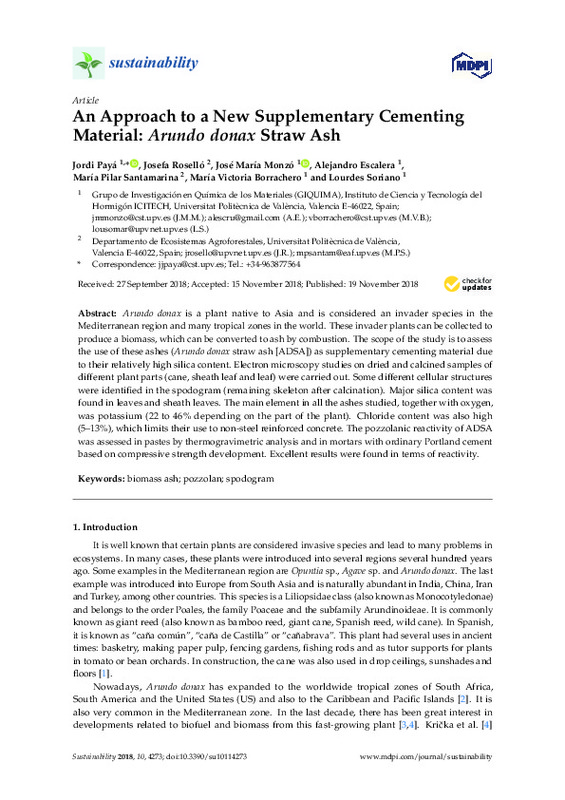JavaScript is disabled for your browser. Some features of this site may not work without it.
Buscar en RiuNet
Listar
Mi cuenta
Estadísticas
Ayuda RiuNet
Admin. UPV
An approach to a new supplementary cementing material: Arundo donax straw ash material
Mostrar el registro sencillo del ítem
Ficheros en el ítem
| dc.contributor.author | Paya Bernabeu, Jorge Juan
|
es_ES |
| dc.contributor.author | Rosello Caselles, Josefa
|
es_ES |
| dc.contributor.author | Monzó Balbuena, José Mª
|
es_ES |
| dc.contributor.author | Escalera, A.
|
es_ES |
| dc.contributor.author | Santamarina Siurana, Mª Pilar
|
es_ES |
| dc.contributor.author | Borrachero Rosado, María Victoria
|
es_ES |
| dc.contributor.author | Soriano Martinez, Lourdes
|
es_ES |
| dc.date.accessioned | 2019-06-08T20:02:19Z | |
| dc.date.available | 2019-06-08T20:02:19Z | |
| dc.date.issued | 2018 | es_ES |
| dc.identifier.uri | http://hdl.handle.net/10251/121820 | |
| dc.description.abstract | [EN] Arundo donax is a plant native to Asia and is considered an invader species in the Mediterranean region and many tropical zones in the world. These invader plants can be collected to produce a biomass, which can be converted to ash by combustion. The scope of the study is to assess the use of these ashes (Arundo donax straw ash [ADSA]) as supplementary cementing material due to their relatively high silica content. Electron microscopy studies on dried and calcined samples of different plant parts (cane, sheath leaf and leaf) were carried out. Some different cellular structures were identified in the spodogram (remaining skeleton after calcination). Major silica content was found in leaves and sheath leaves. The main element in all the ashes studied, together with oxygen, was potassium (22 to 46% depending on the part of the plant). Chloride content was also high (5¿13%), which limits their use to non-steel reinforced concrete. The pozzolanic reactivity of ADSA was assessed in pastes by thermogravimetric analysis and in mortars with ordinary Portland cement based on compressive strength development. Excellent results were found in terms of reactivity. | es_ES |
| dc.language | Inglés | es_ES |
| dc.publisher | MDPI AG | es_ES |
| dc.relation.ispartof | Sustainability | es_ES |
| dc.rights | Reconocimiento (by) | es_ES |
| dc.subject | Biomass ash | es_ES |
| dc.subject | Pozzolan | es_ES |
| dc.subject | Spodogram | es_ES |
| dc.subject | Electron Microscopy Service of the UPV | es_ES |
| dc.subject.classification | BOTANICA | es_ES |
| dc.subject.classification | INGENIERIA DE LA CONSTRUCCION | es_ES |
| dc.title | An approach to a new supplementary cementing material: Arundo donax straw ash material | es_ES |
| dc.type | Artículo | es_ES |
| dc.identifier.doi | 10.3390/su10114273 | es_ES |
| dc.rights.accessRights | Abierto | es_ES |
| dc.contributor.affiliation | Universitat Politècnica de València. Departamento de Ecosistemas Agroforestales - Departament d'Ecosistemes Agroforestals | es_ES |
| dc.contributor.affiliation | Universitat Politècnica de València. Departamento de Ingeniería de la Construcción y de Proyectos de Ingeniería Civil - Departament d'Enginyeria de la Construcció i de Projectes d'Enginyeria Civil | es_ES |
| dc.description.bibliographicCitation | Paya Bernabeu, JJ.; Rosello Caselles, J.; Monzó Balbuena, JM.; Escalera, A.; Santamarina Siurana, MP.; Borrachero Rosado, MV.; Soriano Martinez, L. (2018). An approach to a new supplementary cementing material: Arundo donax straw ash material. Sustainability. 10(11):1-16. https://doi.org/10.3390/su10114273 | es_ES |
| dc.description.accrualMethod | S | es_ES |
| dc.relation.publisherversion | http://doi.org/doi:10.3390/su10114273 | es_ES |
| dc.description.upvformatpinicio | 1 | es_ES |
| dc.description.upvformatpfin | 16 | es_ES |
| dc.type.version | info:eu-repo/semantics/publishedVersion | es_ES |
| dc.description.volume | 10 | es_ES |
| dc.description.issue | 11 | es_ES |
| dc.identifier.eissn | 2071-1050 | es_ES |
| dc.relation.pasarela | S\374514 | es_ES |








